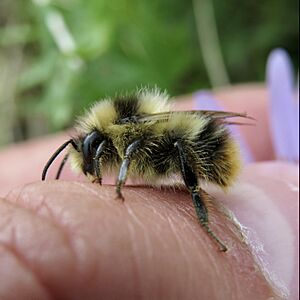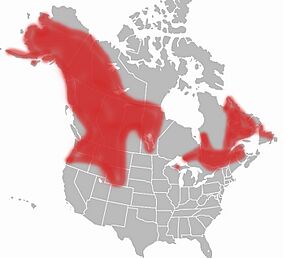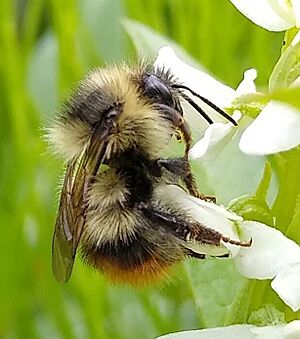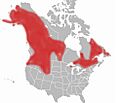Frigid bumblebee facts for kids
Quick facts for kids Frigid bumblebee |
|
|---|---|
 |
|
| Stikine Region, B.C., 2023 | |
| Conservation status | |
| Scientific classification | |
| Genus: |
Bombus
|
| Species: |
frigidus
|
 |
|
The Bombus frigidus, also known as the frigid bumblebee, is a special kind of bumblebee. You can mostly find these rare bees in Canada and some parts of the United States.
These bumblebees are amazing at living in cold places. They can keep their bodies warm inside, even when it's chilly outside. They can also share their body heat to keep their whole colony warm! The frigid bumblebee also has a cool partnership with a flower called Mertensia paniculata. The flower's color tells the bees when it's time to collect sweet nectar.
Contents
About the Frigid Bumblebee
The frigid bumblebee, Bombus frigidus, was first described in 1854. This was done by a scientist named Frederick Smith. He wrote about it in a book called the Catalogue of hymenopterous insects in the collection of the British Museum.
Sometimes, people might confuse this bee with other types, like Bombus mixtus or Bombus balteatus. Frigid bumblebees belong to a big family of insects called Apidae. This family includes other well-known bees like honey bees and stingless bees.
What Frigid Bumblebees Look Like
Frigid bumblebees have a bright yellow thorax, which is the middle part of their body. The first two sections of their abdomen (the back part) are also yellow. There is usually a black stripe between their wings, though some male bees might not have it.
The fourth and fifth sections of their abdomen are orange or yellow. Female frigid bumblebees have black hair on their faces. Males can have either black or yellow hair on their faces. The pollen sack near their back legs, called the corbicular fringe, is a light orange color.
These bees have long hair all over their bodies. Male frigid bumblebees are usually about half the size of the queen bee. The hair on their legs is black for both males and females.
Where Frigid Bumblebees Live
The frigid bumblebee is a rare bee. You can find them from Alaska all the way to the eastern coast of Canada. They also live as far south as Colorado in the United States.
These bees love cold places, so they live in areas with high altitudes or far north latitudes. Their colonies are often built in small burrows in the ground or right on the surface. Even though they are rare, their numbers are not going down like some other bumblebees. Because of this, they are listed as a "Least Concern" species for conservation. This means they are not currently at risk of disappearing.
Frigid Bumblebee Behavior
The Colony's Life Cycle
Like most bumblebees, frigid bumblebees live in a social colony that lasts for one season. The queen bee lives for about a year. During the cold winter, the queen stays hidden in a small chamber underground. This cozy spot is called a hibernaculum.
As soon as the snow melts, usually around mid-May, the queen starts looking for a place to build her nest. Frigid bumblebee queens often leave their winter hiding spots earlier than other bees in cold regions. Arctic bees also develop their eggs faster. This helps them start their colonies quickly, which is important because winter comes back sooner in arctic areas.
The queen flies low to the ground, often stopping to check out possible nest sites. While she's searching, she doesn't carry any pollen. Once she finds a good spot, she starts collecting pollen to make a special clump for her babies. She also builds a wax cup, called a honey pot, to store pollen and nectar.
When the nest is ready, she lays her eggs on the pollen clump. She then keeps them warm with her body. The queen stays in the nest until she needs more food or until the eggs hatch. The eggs hatch in about four days. But it takes about four weeks for the first worker bees to grow into adults.
The colony keeps growing throughout the summer. The queen continues to lay eggs and rarely leaves the nest. The worker bees bring her food, take care of the colony, and help her raise a group of male bees. New queen bees are born shortly after.
The new queens and males leave the colony to find mates around early September. After mating, the male bees die. The new queens collect nectar for a short time before finding their own hibernaculum for the winter.
Mating Habits
Frigid bumblebees have a unique mating behavior compared to most other bumblebees. They only take about ten minutes to mate. This is much shorter than the 30 to 80 minutes other bees might take. This quick mating saves the bees time and energy, and it also helps protect them from predators. After a male bee mates, he usually dies soon after.
How They Control Their Temperature
Larger bees are better at staying warm in cold temperatures than smaller bees. This is because bigger bees have more body volume compared to their surface area. This helps them hold onto the heat their bodies make. Frigid bumblebees are one of the larger types of bumblebees. Queen bees weigh about 0.257 grams and worker bees weigh about 0.130 grams.
The average temperature inside their thorax (the middle part of their body) is about 36.2 degrees Celsius for both queens and workers. This allows them to survive in very cold places and high altitudes where smaller bees would not make it.
However, being larger also has a downside. Bigger bees need to be warmer inside their bodies to start flying. If a bee is too big, it might not be able to get warm enough to fly. This would leave it open to predators and unable to find food. So, there's a perfect size for these bees.
Frigid bumblebees can also move heat from their thorax to their abdomen. They do this to help keep their colony at a steady temperature. To make more heat for the colony, the bee can shiver using its flight muscles in the thorax.
Avoiding Inbreeding
Frigid bumblebees seem to prefer to mate with bees from different nests. They can recognize cues that tell them if another bee is from their own colony or not. We don't know exactly what these cues are. They could be special ways of flying, a scent, or a certain sound.
This bumblebee is one of at least two bumblebee species known to have a way to avoid inbreeding (mating with close relatives). The other species is Bombus bifarius. When fertile queens and males from the same colony meet during mating season, they tend to avoid each other. In general, inbreeding is not very common among bees.
Frigid Bumblebee Interactions
What They Eat
Frigid bumblebees use their medium-short tongues to feed on the sweet nectar of plants. For bees living in the eastern part of North America, their favorite plants include Cirsium (thistles), Epilobium, Geranium, Mertensia (bluebells), Taraxacum (dandelion), and Trifolium (clovers).
For bees in the western part of North America, their diet includes Epilobium, Lupinus, Geranium, Symphoricarpos, Trifolium, and Achillea. The bees bring this nectar back to their colony to feed the young larvae.
Parasites They Face
Frigid bumblebees can be affected by tiny creatures called mites. These mites belong to the genus Pneumolaelaps, and types like longanalis, richardsi, and sinahi are common. You can often find these mites on the honey pots or pollen storage areas in the bee colony.
When mites are on the bees themselves, they are mostly found on queen and male bees, but not usually on worker bees. This might be because only queen bees (and the mites on them) live long enough to survive until the next spring. Male bees often visit nests of their own kind and other species. This gives the mites a chance to spread to new colonies or to new queens.
Their Partnership with Bluebells
The relationship between the frigid bumblebee and the Mertensia paniculata flower (bluebells) is a great example of teamwork. At first, it might seem like the bees are just taking nectar without helping the flower. But there's more to the story!
This special flower has two stages. Young flowers are pink and produce pollen. Older flowers turn blue and produce nectar. When a bee finds a pink flower, it will climb inside to get the pollen. When a bee finds a blue flower, it goes straight for the part that holds the nectar.
These bluebell plants have flowers that bloom one after another. This means one plant can have both pink and blue flowers at the same time. The blue flowers attract bees to the plant. Once there, the bees collect both nectar and pollen. Studies have shown that plants with both blue and pink flowers are twice as likely to be visited by bees compared to plants with only pink flowers. So, the usual mutualistic exchange of food for pollination still happens, just in a clever way!
Protecting Frigid Bumblebees
The biggest danger to the frigid bumblebee is climate change. These bees live in a very specific cold environment. As temperatures rise, these bees might have to move even farther north or they could face extinction.
Warmer temperatures mean snow doesn't stay packed as tightly. This causes it to melt earlier. During the summer, there isn't as much water available. This makes their habitat dry out, and fewer plants bloom. This means less nectar for the bees to eat.
Cold habitats at high elevations usually have fewer types of species. This means their food webs are simpler. So, if frigid bumblebees are harmed by climate change, other species that depend on them will also be negatively affected. This makes the overall problem much worse.
Other threats, though less serious, include losing their habitat, the use of pesticides, and diseases. These diseases can come from bees raised by humans, like honey bees. There's also competition from other bees that are moving north because their own habitats are getting warmer or disappearing.
Frigid Bumblebees and Farming
In Newfoundland, Canada, farmers brought in bee species from other places. They did this to help pollinate and grow more lowbush blueberry plants. However, these imported bees are not native to the area and are often raised on farms. They can carry diseases and parasites that the local bees have no way to fight against.
This has caused a decline in all Bombus species in the area. Sadly, many native plants rely on these local bees for pollination. With fewer natural pollinators, these plants might be replaced by plants that the imported bees prefer. This change in plant life could then reduce the variety of birds and mammals in the area.
Images for kids





